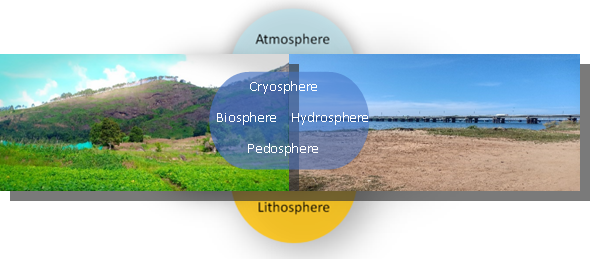
Hydrochemical Analytical Laboratory
Hydrochemical Analytical Laboratory is the part of the Central Chemical Laboratory (CCL) at NCESS with an objective of providing high-quality hydrochemical analytical services to ensure the safe water in natural environment and supports research on water quality and quantity under the global change (a combination of climate change and rapid socio-economic development). The lab not only offers analytical services to NCESS, but also provides the services to other government agencies, public industries, other institutional researchers and private clients on the payment/service basis. This laboratory instruments/facilities offers a complete and customized services for major cation, nutrients, trace metals, rare earth elements and major anion analysis for groundwater, river water, spring water, drinking water, industrial and domestic/agriculture waste water. The laboratory follows the established analytical procedures for analysis of targeted chemical species while available list of instruments/facilities with brief details are provided below.
Instruments/Facilities available with Hydrochemical Analytical Laboratory:
- Continuous Flow Analyser (CFA)
- Microwave Plasma-Atomic Emission Spectrometry (MP-AES)
- UV-VIS-NIR Spectrophotometer (UV-VIS-NIR)
- UV-Vis Spectrophotometer
- Voltametric Analyser (V-analyser)
- Wet Chemistry lab with Millipore water unit
Continuous Flow Analyser (CFA)
Make: Skalar, Netherlands; Model: San++
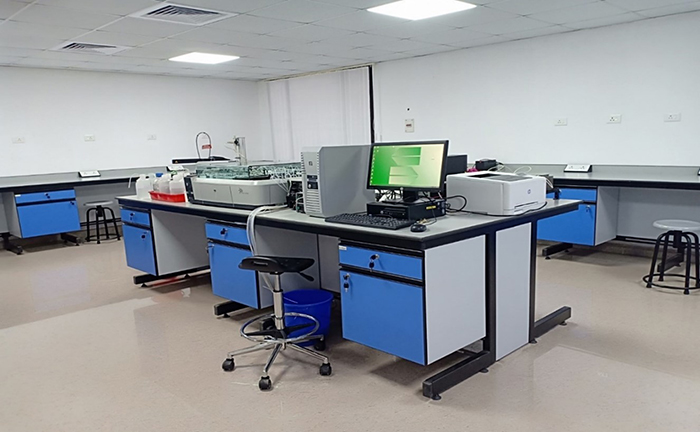
The Continuous Flow Analyser is a segmented flow analyser which is used to measure the amount of nutrients present in estuarine, wastewater, fresh water and seawater samples. The nutrients in sediment and soil samples can be analyzed after proper digestion methods. This instrument is having two chemistry units, in the first one, nutrients such as silicate, ammonia, nitrate, nitrite, phosphate (five chemistries) can be analyzed simultaneously by colorimetric method, while ammonia is measured by fluorometrically. In the second chemistry unit, chloride, sulphate, fluoride, hardness and alkalinity (another five chemistries) can be analyzed by the colorimetric method. Apart from this total nitrogen and total phosphorus also can be analyzed separately with high accuracy and precision. The Continuous Flow Analyzer consists of computer-controlled sampler for up to 140 samples with separated standard and sample positions, built in rinse pump, optional automatic diluter station for automatic pre- and post-run dilutions, and automatic standard preparation. The method of analysis is segmented flow of reagents and samples running through a chemistry module to undergo handlings like mixing, heating, dialysis, distillation, etc. until a reaction product is developed. Then the flow passes through a flow cell and the absorbance are measured according to the Beer-Lambert law. The instrument is capable of measuring the elements/ions/compounds in ppb levels.
Microwave Plasma-Atomic Emission Spectrometry (MP-AES)
Make: Agilent; Model: 4210
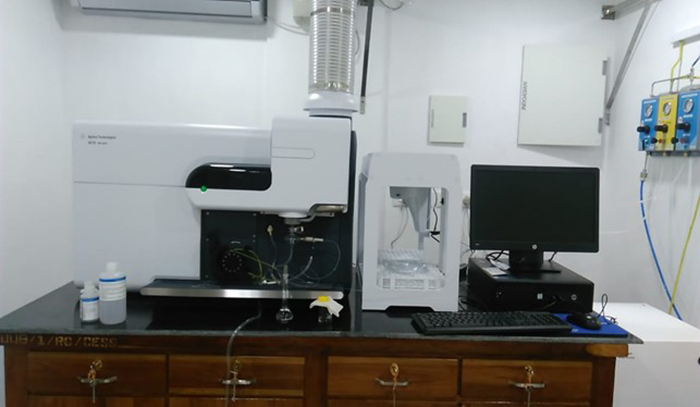
The Microwave Plasma-Atomic Emission Spectrophotometer (MP-AES) system is useful in identifying and quantifying the metal elements (almost all non-radioactive metals in the periodic table) which is a cost-efficient and easy-to-use for a wide range of applications from routine to complex precious metals analysis. This system offers higher sensitivity and faster throughput capabilities than flame atomic absorption. MP-AES runs on nitrogen extracted from air using the nitrogen generator and hence no spending on the He/Ar gas cylinders like the ICP-MS. The plasma once generated will sustain by axial magnetic and radial electrical fields and the analytical samples are typically nebulized prior to interaction with the plasma. The atomized sample passes through the plasma where the metal atoms electrons are promoted to the excited state by absorbing energy from the plasma. When de-excitation takes place the wavelength which is characteristic to the particular metal atom will be emitted. The light beam emitted from different metal atoms will be focused by using the optical system and then focused beam is split into monochromatic wavelengths by using the prism and the intensity of each emission are detected using the highly efficiency CCD (Charge Coupled Device) detector. Major metal ions and trace metal analysis of liquid samples can be carried out instantaneously while the soil/sediment/rock samples must be extracted to liquid form by using the proper digestion techniques, then only can be injected into MP-AES and any high concentrations of the analyte must be diluted to standards limits range.
UV-VIS-NIR Spectrophotometer
Make: Shimadzu; Model: UV-3600 plus
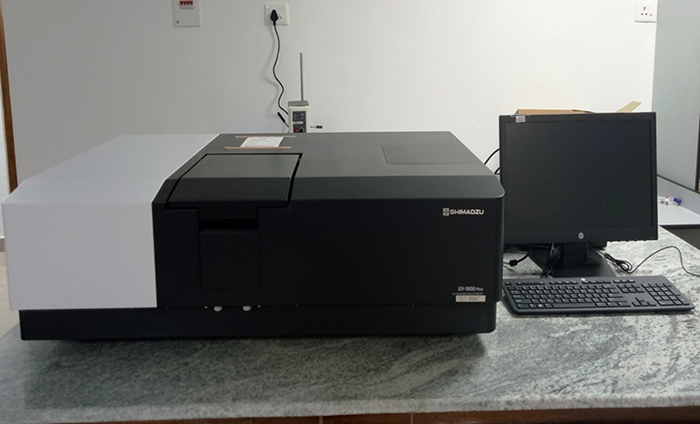
The optical absorption of samples in the wide range of 185 to 3300 nm regions are measured by using this instrument for a given solid or liquid samples with different detection modes for different samples. Absorption measurements based on the Beer-Lambert law in the UV, Visible and Near IR regions of the electromagnetic spectrum provides the information about electronic transitions in a given sample and thereby can detect the concentration of the analyte with respect to the standards. For example, amount of sulphate in the given sample can identified and quantified by using the absorbance at 420 nm, like wise any chemical species which has the absorbance maxima between 185 and 3300 nm can be identified as well as quantified by using this UV-VIS-NIR Spectrophotometer. A wide range of elements/compounds in the environment can be quantitatively identified using colorimetric procedure. The concentrations of UV active compounds and VIS active dyes can be determined directly without the addition of colouring reagents.
Voltametric Analyser
Make: Metrohm; Model: 797 VA Computrace
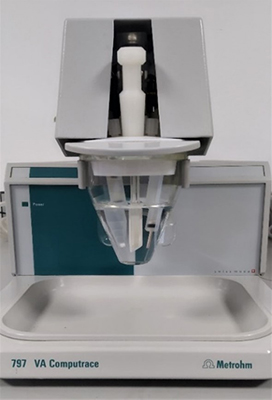
The 797 VA Computrace is a modern Voltametric measuring stand that is connected to a PC via a USB port and the computer software provided, controls the measurement, records the measured data and evaluates it. Voltametric trace analysis and additive determination in electroplating baths with a single instrument provides the possibility to carry out metal analyses with improved sensitivity. With this Voltametric Analyser, it is also possible to differentiate between various oxidation states of metal ions or between free and bound metal ions. Not only metals, but also many different organic compounds can be determined by voltammetry. A range of special anions can also be determined voltametrically, particularly the environmental relevant species such as cyanide, sulfide or nitrite and nitrate.
Wet Chemistry Lab
The CCL at NCESS is equipped with a brand new futuristic Wet Chemical Lab with adequate safety measures as well as standard reagents and glassware apparatus. This includes standard benchwork set up for titrations, preparation of reagents and standards, microbalance with anti-vibrating table, fume hood, filtration unit, standard chemical storage and Millipore unit for water purification. A laboratory fume hood is a ventilated enclosure that is built inside a chemistry lab for conducting experiments that release toxic chemicals. The fume hoods have an efficient air exhaust system that allows expulsion of toxic gases. The water used for the laboratory needs are taken from Millipore water system which combines the production of Type 2 (pure) water and Type 1 (ultrapure) water in a single unit directly from tap water. Vacuum filtration is a technique for separating a solid product from a liquid. The water samples are poured through a filter paper in a Buchner funnel by which the solids present in the water are trapped by the filter and the liquid is drawn through the funnel into the flask below by using the vacuum pump. The chemicals that are required for the laboratory works are stored in a well-arranged manner in the chemical store.
Standard bench work set up in the Wet Chemistry Lab 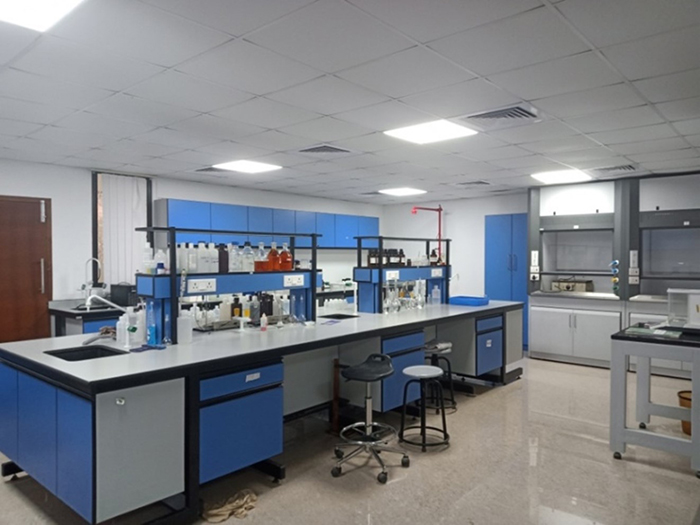
Fume hood set up in the Wet Chemistry Lab 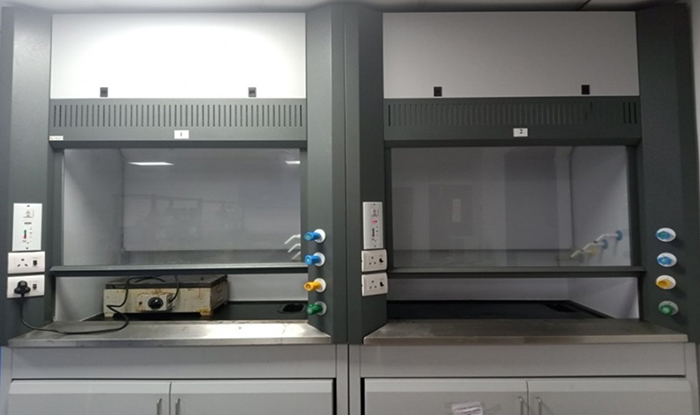
Millipore water purification unit in the Wet Chemistry Lab 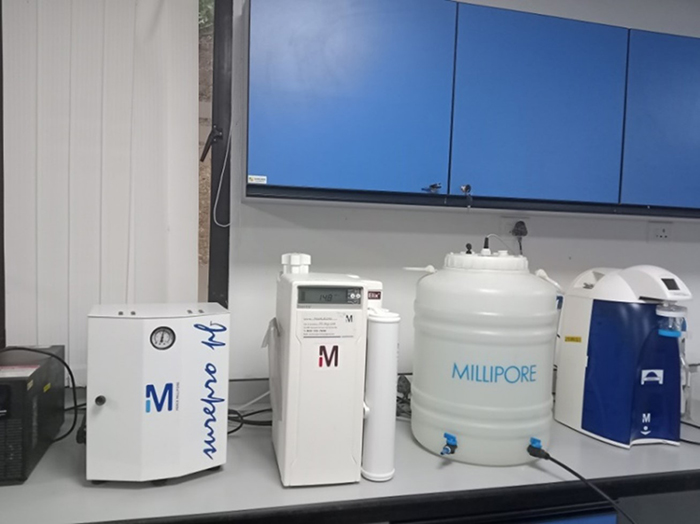




 RTI Act
RTI Act
